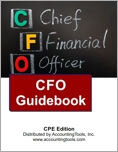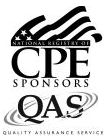CFO Guidebook (CPE Course)
CPE Credit: 22 hours
Course Type: Downloaded PDF materials with online test
Price (with PDF Textbook): $155
Course Description
The CFO manages the financial structure and oversees the financial performance of an organization, so this is a critical and demanding management position. The CFO Guidebook provides the CFO with detailed advice regarding how to be most effective in every aspect of the job. The course covers all parts of the CFO's traditional finance role, including budgeting, fundraising, investments, going public, investor relations and share management. It goes on to address more recent additions to the job, such as strategic planning, risk management, the control environment, and information technology. Given its comprehensive coverage of the CFO position, The CFO Guidebook can serve as a reference manual for anyone wanting to become more effective in the position.
Author: Steven Bragg
Course Number: FN1002
Table of Contents
Chapter 1. The CFO Position
Chapter 2. Strategic Planning
Chapter 3. Risk Management
Chapter 4. The Control Environment
Chapter 5. Performance Measurement
Chapter 6. Mergers and Acquisitions
Chapter 7. Budgeting and Forecasting
Chapter 8. Product Pricing
Chapter 9. Capital Budgeting
Chapter 10. Cash Management
Chapter 11. Investment Management
Chapter 12. Fund Raising with Debt
Chapter 13. Fund Raising with Equity
Chapter 14. Credit Rating Agencies
Chapter 15. Going Public and Going Private
Chapter 16. Stock Exchanges
Chapter 17. Investor Relations
Chapter 18. Public Company Financial Reporting
Chapter 19. Share Management
Chapter 20. Information Technology
Learning Objectives
Identify the key responsibilities of the CFO position, and key aspects of CFO relations with the controller and CEO.
Specify the stages in strategy development, strategy types, and the role of the CFO in strategy.
Cite the methods for identifying and mitigating risks, especially in regard to foreign exchange risk and interest rate risk.
Identify the types of controls, when they should be used, and the characteristics of better controls.
Recognize the characteristics of the cash conversion cycle.
Identify the strategies under which acquisitions are made, the steps in the due diligence process, the characteristics of a strong acquisition candidate, and the various methods for valuing an acquisition candidate.
Specify the advantages and disadvantages of budgeting, types of budgets, and how to operate without a budget.
Itemize the different types of product pricing, and the situations in which they are most useful.
Identify the methods and concepts used to evaluate capital budgeting proposals, as well as the alternatives to fixed asset acquisition.
State the methods used to construct and update a cash forecast, as well as the methods employed to concentrate cash for investment purposes.
Cite the available cash investment strategies and the more common investment instruments.
Identify the types of debt funding, and associated covenants.
Specify the types of equity funding, the investor rights associated with these instruments, and the types of investors who may invest in them.
Identify the main credit rating agencies, the types of credit ratings, and the process for obtaining and appealing a credit rating.
Specify the processes by which a company can go public or take itself private, and the reasons for going public or private.
Cite the reasons for being listed on a stock exchange, and the qualifications for listing on the various exchanges.
Identify the participants in and topics covered by an earnings call, the use of guidance, the topics covered in a road show, and the regulations governing investor relations.
Identify the major public company reports, key reporting concepts, and the method by which reports are filed with the Securities and Exchange Commission.
Specify how float can be increased, as well as alternative methods for selling shares.
State how competitive advantage can be gained from the use of information technology (IT), as well as how to manage risk with IT.
Level: Overview
Instructional Method: QAS Self-Study
NASBA Category: Finance
Prerequisites: None
Advance Preparation: None
Latest Review Date: July 2023
Program Registration Requirements: Click on "Purchase Course" near the top of this page to pay for and access the course. You will then be able to download the course as a PDF file, then take an on-line examination, and then download a certificate of completion if you pass the examination.
Program Refund Policy: For more information regarding administrative policies concerning complaints, refunds, and other matters, see our policies page.
AccountingTools, Inc. is registered with the National Association of State Boards of Accountancy (NASBA) as a sponsor of continuing professional education on the National Registry of CPE Sponsors. State boards of accountancy have the final authority on the acceptance of individual courses for CPE credit. Complaints regarding registered sponsors may be submitted to the National Registry of CPE Sponsors through its website: www.nasbaregistry.org.
The NASBA sponsor identification number for Accountingtools, Inc. is 115881.
AccountingTools is an IRS Approved Continuing Education Provider. We are compliant with the requirements for continuing education providers (as described in sections 10.6 and 10.9 of the Department of Treasury’s Circular No. 230 and in other IRS guidance, forms, and instructions). Our IRS Approved Continuing Education Provider number is 72821.


